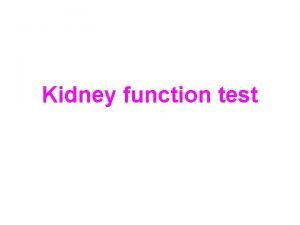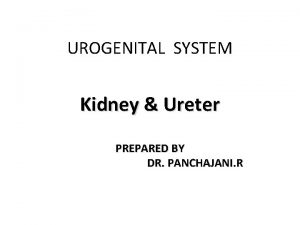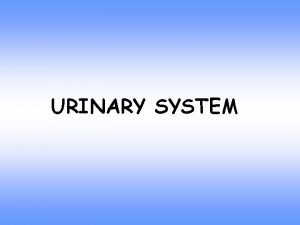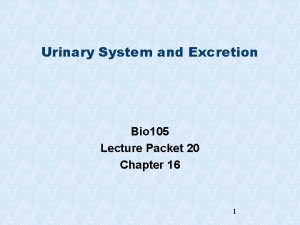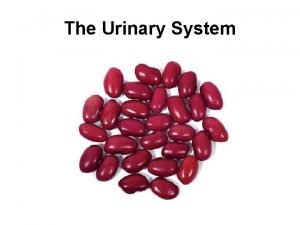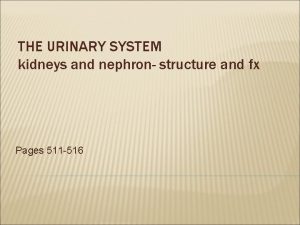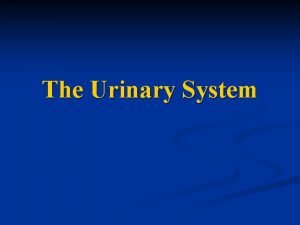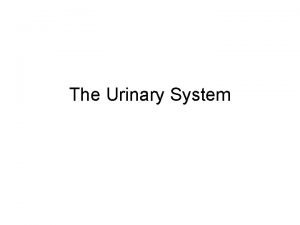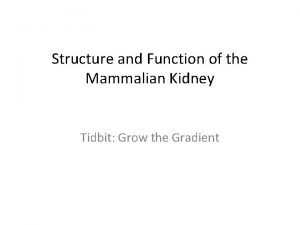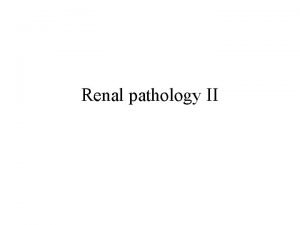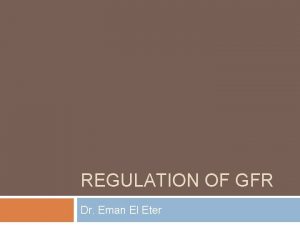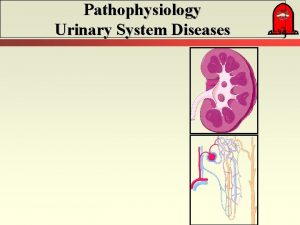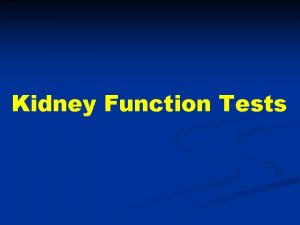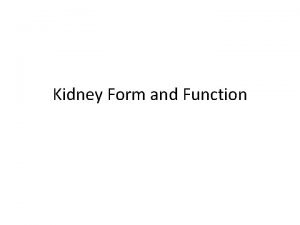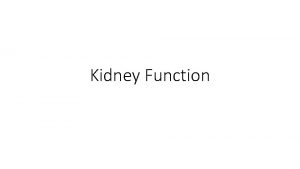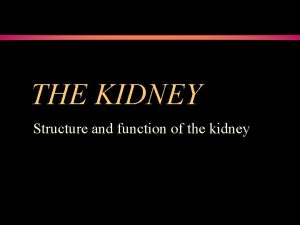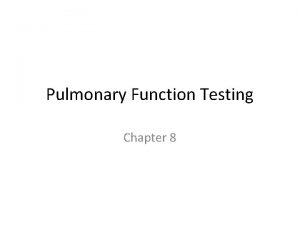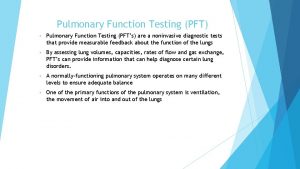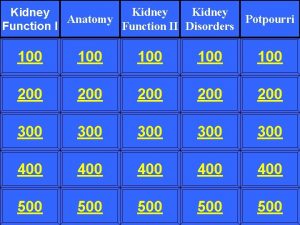Kidney Function Testing DR SAID AL GHORA An




































- Slides: 36

Kidney Function Testing DR. SAID AL GHORA

An Introduction to the Urinary System Produces urine Transports urine towards bladder Temporarily store urine Conducts urine to exterior

The Function of Urinary System A) q Excretion & Elimination: removal of organic wastes products from body fluids (urea, creatinine, uric acid) B) q Homeostatic regulation: Water -Salt Balance Acid - base Balance C) q Enocrine function: Hormones

Kidney – basic data Urine excreted daily in adults: cca 1. 5 L Kidney only ca 1% of total body weight, despite it The renal blood flow= 20% of cardiac output Plasma renal flow= PRF ca 600 m. L/Min. /1. 73 M 2 Reflects two processes Ultrafiltration (GFR): 180 L/day Reabsorption: >99% of the amount filtered

Renal threshold of a substance is the concentration in blood beyond which it is excreted in urine Renal threshold for glucose is 180 mg/d. L Tubular maximum (Tm): maximum capacity of the kidneys to absorb a particular substance Tm for glucose is 350 mg/min

Kidney Function A plumbers view

How do you know it’s broken? Decreased urine production Clinical symptoms Tests

Where can it break? Pre-renal Renal (intrarenal) Post-renal (obstruction)

Causes of kidney functional disorders Pre-renal e. g. decreased intravascular volum Renal e. g. acute tubular necrosis Postrenal e. g. ureteral obstruction

Signs and Symptoms of Renal Failure Symptoms of Uraemia (nausea, vomiting, lethargy) Disorders of Micturation (frequency, nocturia, dysuria) Disorders of Urine volume (polyuria, oliguria, anuria) Alterations in urine composition (haematuria, proteinuria, bacteriuria, leukocytouria, calculi) Pain Oedema (hypoalbuminaemia, salt and water retention)

Why Test Renal Function? To identify renal dysfunction. To diagnose renal disease. To monitor disease progress. To monitor response to treatment. To assess changes in function that may impact on therapy (e. g. Digoxin, chemotherapy).

When should you assess renal function? Older age Family history of Chronic Kidney disease (CKD) Decreased renal mass Low birth weight Diabetes Mellitus (DM) Hypertension (HTN) Autoimmune disease Systemic infections Urinary tract infections (UTI) Nephrolithiasis Obstruction to the lower urinary tract Drug toxicity

Biochemical Tests of Renal Function Measurement of GFR Clearance tests Plasma creatinine Urea, uric acid and β 2 -microglobulin Renal tubular function tests Osmolality measurements Specific proteinurea Glycouria Aminoaciduria Urinalysis Appearance Specific gravity and osmolality p. H osmolality Glucose Protein Urinary sediments

Biochemical Tests of Renal Function Measurement of GFR Clearance tests Plasma creatinine Urea, uric acid and β 2 -microglobulin

Biochemical Tests of renal function In acute and chronic renal failure, there is effectively a loss of function of whole nephrons Ø Filtration is essential to the formation of urine tests of glomerular function are almost always required in the investigation and management of any patient with renal disease. ØThe most frequently used tests are those that assess either the GFR or the integrity of the glomerular filtration barrier.

Measurement of glomerular filtration rate GFR can be estimated by measuring the urinary excretion of a substance that is completely filtered from the blood by the glomeruli and it is not secreted, reabsorbed or metabolized by the renal tubules. Ø Clearance is defined as the (hypothetical) quantity of blood or plasma completely cleared of a substance per unit of time. V is not urine volume, it is urine flow rate Ø Clearance of substances that are filtered exclusively or predominantly by the glomeruli but neither reabsorbed nor secreted by other regions of the nephron can be used to measure GFR. Ø Inulin ØThe Volume of blood from which inulin is cleared or completely removed in one minute is known as the inulin clearance and is equal to the GFR. ØMeasurement of inulin clearance requires the infusion of inulin into the blood and is not suitable for routine clinical use

Biochemical Tests of Renal Function Measurement of GFR Clearance tests Plasma creatinine Urea, uric acid and β 2 -microglobulin

Creatinine Ø 1 to 2% of muscle creatine spontaneously converts to creatinine daily and released into body fluids at a constant rate. ØEndogenous creatinine produced is proportional to muscle mass, it is a function of total muscle mass the production varies with age and sex Ø Dietary fluctuations of creatinine intake cause only minor variation in daily creatinine excretion of the same person. Ø Creatinine released into body fluids at a constant rate and its plasma levels maintained within narrow limits Creatinine clearance may be measured as an indicator of GFR.

Creatinine clearance and clinical utility ØThe most frequently used clearance test is based on the measurement of creatinine. Ø Small quantity of creatinine is reabsorbed by the tubules and other quantities are actively secreted by the renal tubules So creatinine clearance is approximately 7% greater than inulin clearance. ØThe difference is not significant when GFR is normal but when the GFR is low (less 10 ml/min), tubular secretion makes the major contribution to creatinine excretion and the creatinine clearance significantly overestimates the GFR.

Creatinine clearance clinical utility ØAn estimate of the GFR can be calculated from the creatinine content of a 24 -hour urine collection, and the plasma concentration within this period. ØThe volume of urine is measured, urine flow rate is calculated (ml/min) and the assay for creatinine is performed on plasma and urine to obtain the concentration in mg per dl or per ml. Creatinine clearance in adults is normally about of 120 ml/min, The accurate measurement of creatinine clearance is difficult, especially in outpatients, since it is necessary to obtain a complete and accurately timed sample of urine

Creatinine clearance and clinical utility ØThe 'clearance' of creatinine from plasma is directly related to the GFR if: ØThe urine volume is collected accurately ØThere are no ketones or heavy proteinuria present to interfere with the creatinine determination. ØIt should be noted that the GFR decline with age (to a greater extent in males than in females) and this must be taken into account when interpreting results.

Use of Formulae to Predict Clearance • Formulae have been derived to predict Creatinine Clearance (CC) from Plasma creatinine. • Plasma creatinine derived from muscle mass which is related to body mass, age, sex. • Cockcroft & Gault Formula CC = k[(140 -Age) x weight(Kg))] / serum Creatinine (µmol/L) k = 1. 224 for males & 1. 04 for females • Modifications required for children & obese subjects • Can be modified to use Surface area

Biochemical Tests of Renal Function Measurement of GFR Clearance tests Plasma creatinine Urea, uric acid and β 2 -microglobulin

Measurement of nonprotein nitrogencontaining compounds Catabolism of proteins and nucleic acids results in formation of so called nonprotein nitrogenous compounds. Protein Proteolysis, principally enzymatic Amino acids Transamination and oxidative deamination Ammonia Enzymatic synthesis in the “urea cycle” Urea

Plasma Urea is the major nitrogen-containing metabolic product of protein catabolism in humans, ü Its elimination in the urine represents the major route for nitrogen excretion. ü More than 90% of urea is excreted through the kidneys, with losses through the GIT and skin ü Urea is filtered freely by the glomeruli ü Plasma urea concentration is often used as an index of renal glomerular function ü Urea production is increased by a high protein intake and it is decreased in patients with a low protein intake or in patients with liver disease.

Plasma Urea Many renal diseases with various glomerular, tubular, interstitial or vascular damage can cause an increase in plasma urea concentration. ØThe reference interval for serum urea of healthy adults is 5 -39 mg/dl. Plasma concentrations also tend to be slightly higher in males than females. High protein diet causes significant increases in plasma urea concentrations and urinary excretion. ØMeasurement of plasma creatinine provides a more accurate assessment than urea because there are many factors that affect urea level. ØNonrenal factors can affect the urea level (normal adults is level 5 -39 mg/dl) like: üMild dehydration, ühigh protein diet, üincreased protein catabolism, muscle wasting as in starvation, üreabsorption of blood proteins after a GIT haemorrhage, ütreatment with cortisol or its synthetic analogous

Clinical Significance States associated with elevated levels of urea in blood are referred to as uremia or azotemia. Causes of urea plasma elevations: Ø Ø Ø Prerenal: renal hypoperfusion Renal: acute tubular necrosis Postrenal: obstruction of urinary flow

Uric acid Ø In human, uric acid is the major product of the catabolism of the purine nucleosides, adenosine and guanosine. Ø Purines are derived from catabolism of dietary nucleic acid (nucleated cells, like meat) and from degradation of endogenous nucleic acids. Ø Overproduction of uric acid may result from increased synthesis of purine precursors. Ø In humans, approximately 75% of uric acid excreted is lost in the urine; most of the reminder is secreted into the GIT

Uric acid ØRenal handling of uric acid is complex and involves four sequential steps: ØGlomerular filtration of virtually all the uric acid in capillary plasma entering the glomerulus. ØReabsorption in the proximal convoluted tubule of about 98 to 100% of filtered uric acid. ØSubsequent secretion of uric acid into the lumen of the distal portion of the proximal tubule. ØFurther reabsorption in the distal tubule. Ø Hyperuricemia is defined by serum or plasma uric acid concentrations higher than 7. 0 mg/dl (0. 42 mmol/L) in men or greater than 6. 0 mg/dl (0. 36 mmol/L) in women

Plasma β 2 -microglobulin Øβ 2 -microglobulin is a small peptide (molecular weight 11. 8 k. Da), ØIt is present on the surface of most cells and in low concentrations in the plasma. ØIt is completely filtered by the glomeruli and is reabsorbed and catabolized by proximal tubular cells. ØThe plasma concentration of β 2 -microglobulin is a good index of GFR in normal people, being unaffected by diet or muscle mass. ØIt is increased in certain malignancies and inflammatory diseases. ØSince it is normally reabsorbed and catabolized in the tubules, measurement of β 2 -microglobulin excretion provides a sensitive method of assessing tubular integrity.

Role of Biochemical Testing Presentation of patients: Routine urinalysis Symptom or physical sign Systemic disease with known renal component. Effective management of renal disease depends upon establishing a definitive diagnosis: Detailed clinical history Diagnostic imaging and biopsy Role of biochemistry: Rarely establishes the cause Screening for damage Monitoring progression.

Creatinine Clearance Timed urine collection for creatinine measurement (usually 24 h) Blood sample taken within the period of collection. Normal range = 120 -145 ml/min Problems: Practical problems of accurate urine collection and volume measurement. Within subject variability = 11%

Plasma Creatinine Concentration Difficulties: Concentration depends on balance between input and output. Production determined by muscle mass which is related to age, sex and weight. High between subject variability but low within subject. Concentration inversely related to GFR. Small changes in creatinine within and around the reference limits = large changes in GFR.

Effect of Muscle Mass on Serum Creatinine Normal Muscle Mass Normal Kidneys Diseased Kidneys Increased Muscle Mass Reduced Muscle Mass Creatinine Input Plasma Pool Content Kidney Output Normal Kidneys Diseased Kidneys

Acute Renal Failure Metabolic features: Retention of: Urea & creatinine Na & water potassium with hyperkalaemia Acid with metabolic acidosis Classification of Causes: Pre-renal reduced perfusion Renal inflammation infiltration toxicity Post-renal obstruction

Pre-renal versus intrinsic ARF
 A little bird by aileen fisher
A little bird by aileen fisher Topper learning.com
Topper learning.com Non excretory function of kidney
Non excretory function of kidney 7 functions of the kidney
7 functions of the kidney Domain testing in software testing methodologies
Domain testing in software testing methodologies Kv charts in software testing
Kv charts in software testing Data flow testing strategies in software testing
Data flow testing strategies in software testing Positive and negative testing
Positive and negative testing Static testing and dynamic testing
Static testing and dynamic testing What is globalization testing
What is globalization testing Neighborhood integration testing
Neighborhood integration testing Cause effect graph for triangle problem
Cause effect graph for triangle problem Control structure testing in software testing
Control structure testing in software testing Decision table testing in software testing
Decision table testing in software testing Decision table advantages and disadvantages
Decision table advantages and disadvantages Pengertian black box
Pengertian black box Behavior testing adalah
Behavior testing adalah Decision table for triangle problem
Decision table for triangle problem Rigorous testing in software testing
Rigorous testing in software testing Testing blindness in software testing
Testing blindness in software testing Component testing is a black box testing
Component testing is a black box testing Types of domain testing
Types of domain testing Pathophysiology of kidney stones
Pathophysiology of kidney stones Bellinior
Bellinior What are the three regions of the kidney
What are the three regions of the kidney Kidney infection
Kidney infection 3 layers of the kidney
3 layers of the kidney Cortical radiate artery
Cortical radiate artery Kidney lobe vs lobule
Kidney lobe vs lobule Abnormal constituents of urine
Abnormal constituents of urine Tubule
Tubule Slk medical abbreviation transplant
Slk medical abbreviation transplant Pathology
Pathology Tubuloglomerular feedback mechanism
Tubuloglomerular feedback mechanism Urinary tract obstruction
Urinary tract obstruction Coverings of kidney
Coverings of kidney Kaarlo hinkkala
Kaarlo hinkkala



